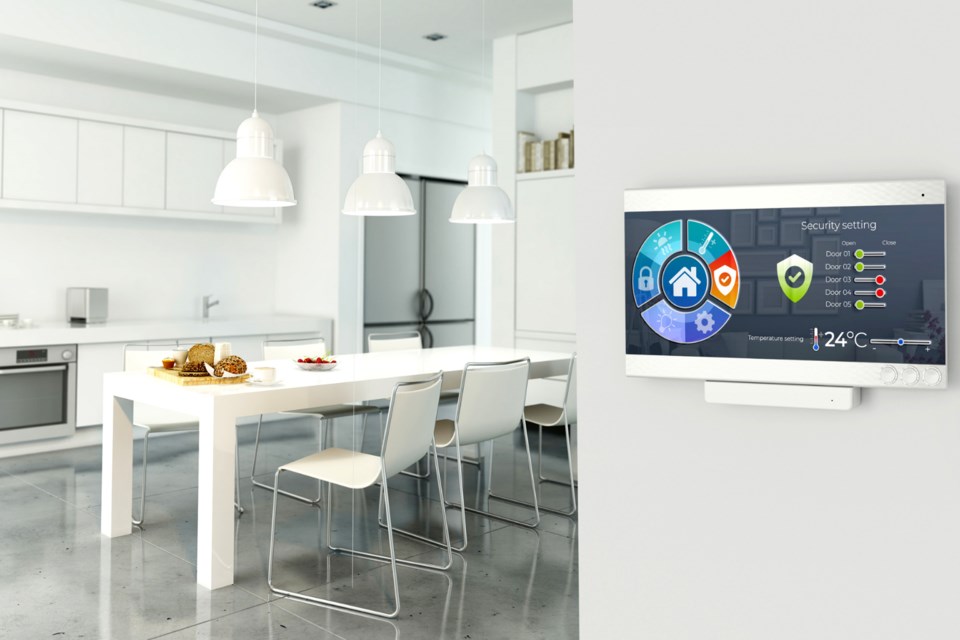Smart technology is a phrase that is used to describe the various gadgets, devices and electronics that are used for functions within the home and can be accessed and controlled from your phone or computers, specifically across the Internet. An example would be a smart thermostat that you can increase or lower the temperature as needed. If it were a hot day, you could use your phone to change the temperature of the house to cooler before you left work, so that by the time you arrived home, it was a comfortable climate.
Home automation is the concept of integrating the smart technology into a system that responds to anticipated needs and actions of the home residents with little control from them. It “learns” from past actions to predict future actions. For example, the thermostat as mentioned above could also recognize the pattern of cooling the house at 4:30 pm on weekdays to 20 degrees, and then adjust accordingly. Instead of setting the temperature to cool down before you leave work, it would automatically do this without any need on your end.
A lot of smart technology also has home automation within it, but ideally for the best form of home automation, you would want a hub of some sort. A hub is where all the smart technology would converge and communicate with each other to elevate your home automation. Think of it as a staff meeting. Each can go off and do their own thing, but when they come together and make a plan, it is more effectively coordinated and executed.
Some various types of smart technology that are available for residents to use in their home automation are:
- LED lights that change colour and brightness
- cameras both interior and exterior
- door bells and locks
- security systems
- window coverings, appliances – large and small; and
- television, baby monitors and Wi-Fi access, but the list goes on as there is virtually no end to what can be incorporated.
What are some of the pros and cons when it comes to home automation?
Like most everything there are great things about it and things that could potentially cause issues, so it is very important that you research and understand them to enable you to make an informed decision about it.
Cons connected to smart homes are cost, reliance on a solid Internet connection, possible technical glitches and dependency, security issues (hacking), devices being compatible and tech becoming outdated.
The benefits include convenience, security and safety, time efficiency, elevate comfort, save money, increase resale value and being in control while you are away at the push of a button.
The remarkable thing about smart homes is that they can also be targeted towards certain demographics to ensure safety and independence. It is here where the biggest impact will be felt from home automation.
When it comes to seniors and people with various disabilities, a smart home will provide them with the needed supports to ensure that they are able to live in their homes for as long as possible with privacy and dignity. Service and care providers can use a monitoring system for example, that if the fridge door or bathroom light hasn’t been activated in a certain time frame a notification would be sent. This would alert the assigned offsite care giver, to provide a wellness check and confirm the person is alright.
It is functions like this that would provide less invasive means of care and support to ensure that people are safe. It should be seriously considered when choosing to age in place, or to set up an independent living situation for those who may require some assistance.
Integrating smart technology into the home has a large range of costs from very little up to hundreds of thousands of dollars depending on the systems. You can enjoy the flexibility of adding little bits over time to make it more affordable, but if you are considering a complex system that would require extensive work, it makes sense to do it all at once to keep costs down overall.
When building a new home, it would be a great time to think about home automation while in the planning phase so that various structural elements, specifically electrical, could be set up appropriately and implemented in the correct timeline for construction. It would save money and time in the long run, no matter how complex the automation system is.
When integrating smart or automated technologies, it’s important to plan ahead to save time and costs. For example, automated blinds would require additional electrical work near the windows, so waiting until the house is almost complete to choose automated blinds would result in another visit and bill from the electrician. This could also affect work from drywallers, painters, and other trades on the project that could increase your costs if not thoroughly planned up front.
The bottom line is – if you’re smart about planning your home automation or smart systems, you can save time and money while getting the home and functionality you desire.
Interested in learning how you can automate your home? Drop me a line.
Kara Murray, Partner
Alair Homes St. Albert




